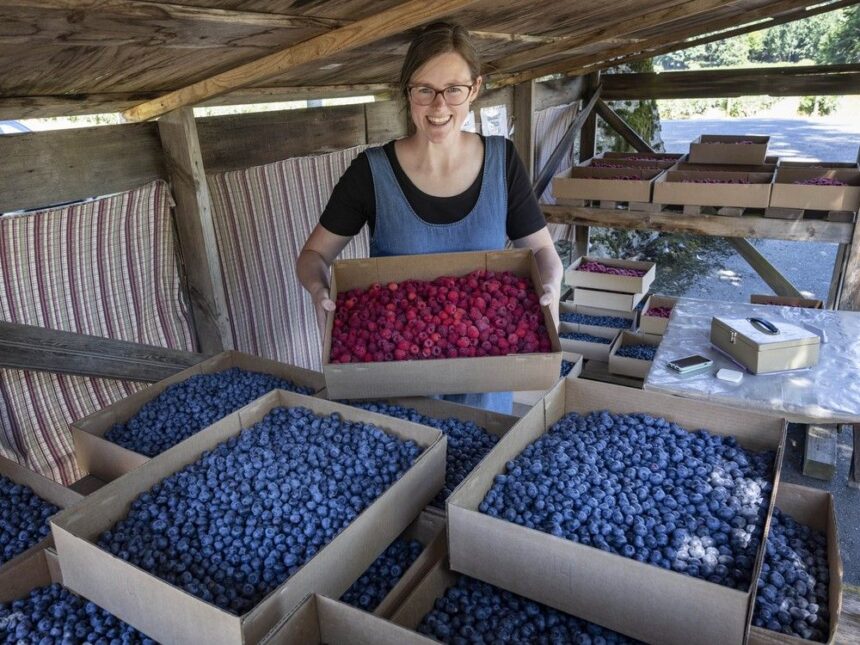I strapped on mud-caked boots last weekend and followed fourth-generation farmer Sam Etsell through his family’s strawberry fields in Abbotsford’s Sumas Prairie. The morning dew still clung to the leaves as families hunched between rows, filling buckets with ruby-red berries.
“Five years ago, we’d get maybe 20 cars on a Saturday. Now? The parking lot’s full before 9 a.m.,” Etsell told me, gesturing toward the overflowing gravel area where vehicles displayed license plates from Vancouver, Surrey, and even Washington State. “People aren’t just buying berries anymore. They want to know who grew their food.”
This renaissance of farm-direct purchasing isn’t isolated to the Fraser Valley. Across British Columbia, farmers markets, U-pick operations, and farm-gate sales have exploded in popularity, defying economic headwinds that have challenged other retail sectors.
According to the BC Association of Farmers’ Markets, market attendance jumped 23% last year compared to pre-pandemic levels, with over 145 markets now operating province-wide. The direct farm-to-consumer pipeline now represents nearly $250 million in annual economic activity.
Hannah Wittman, Professor at UBC’s Centre for Sustainable Food Systems, explains this shift reflects deeper changes in consumer consciousness. “We’re seeing a fundamental revaluation of food systems. Consumers increasingly vote with their dollars for transparency, locality, and environmental sustainability.”
The surge accelerated during the pandemic when supply chain disruptions left grocery store shelves periodically bare. Those early shocks created lasting buying habits, says Heather O’Hara, executive director of the BC Association of Farmers’ Markets.
“COVID was the catalyst that reconnected many urban British Columbians with local food systems. What began as panic-buying has evolved into purposeful purchasing,” O’Hara noted during our conversation at the Trout Lake Farmers Market in East Vancouver, where I counted 76 vendors on a recent Saturday.
The data supports this shift. A BC Ministry of Agriculture survey found that 67% of provincial residents purchased farm-direct products in 2022, up from 41% in 2019. Direct farm marketing has grown by double digits annually since 2020.
For Pemberton potato farmer Anna Helmer, this growth has transformed her business model. “Eight years ago, I sold 80% wholesale to restaurants and 20% direct to customers. Today, that ratio has completely flipped,” she told me while bagging potatoes at the Whistler Farmers Market.
This relationship-based commerce comes with practical advantages beyond just fresher food. When record-breaking heat desiccated crops across the province last summer, Helmer’s loyal customers understood why her potatoes were smaller.
“That’s the beauty of direct relationships,” she said. “My customers aren’t just buying potatoes. They’re investing in a food system that’s resilient because it’s transparent.”
The economics make sense for producers and consumers alike. Farmers typically retain 80-85 cents of every dollar in direct sales, compared to just 15-20 cents through conventional distribution channels, according to BC Ministry of Agriculture figures.
For shoppers, prices at farmers markets have become increasingly competitive with supermarkets, especially for seasonal produce. My own price comparison at three Vancouver locations found farmers market strawberries averaging just 50 cents more per pound than major grocery chains, with tomatoes and leafy greens priced nearly identically.
The shift extends beyond just fruits and vegetables. Meat producers have seen particular growth, with demand for farm-direct beef, pork, and poultry outstripping supply across the province.
Julia Smith, who raises heritage pigs at Blue Sky Ranch in Merritt, has a waitlist for her pork shares that stretches months long. “Consumers want to know their meat wasn’t raised in a factory setting,” Smith explained. “They’re asking questions about antibiotics, animal welfare, and environmental practices that conventional food systems simply don’t address.”
Digital innovation has accelerated this transition. Where farm-direct shopping once required multiple stops and inconvenient hours, online ordering systems now allow consumers to purchase from multiple farms for centralized pickup or delivery.
The Farm Folk City Folk society reports that BC now hosts 28 online farmers markets and cooperative buying platforms, up from just three in 2019. These platforms collectively serve over 30,000 regular customers.
In Richmond, the Kwantlen St. Farmers Market has introduced a digital pre-ordering system that’s proven particularly popular with younger consumers. Market manager Lily Qiu notes that customers in their 20s and 30s represent their fastest-growing demographic.
“The younger generation wants convenience without compromising their values,” Qiu said. “They’ll research farming practices online before visiting our market in person.”
Climate concerns also drive this trend. Transportation accounts for roughly 11% of food’s carbon footprint, according to Environment Canada. As British Columbians grow increasingly climate-conscious, “food miles” have become a purchasing consideration.
Back in Abbotsford, farmer Etsell points to another factor: the simple pleasure of connection. Children squeal with delight as they discover perfectly ripe berries hidden beneath leaves. Parents photograph the experience for social media. The farm store buzzes with conversation.
“People are hungry for experiences as much as food,” Etsell observed. “They want stories they can share at dinner, not just ingredients.”
As I left the farm with berries still warm from the sun, I noticed something telling: at least half the vehicles in the parking lot displayed the same urban demographics that fill Kitsilano coffee shops and Coal Harbour condos. The urban-rural divide, at least in our food systems, appears to be narrowing.
Whether driven by food security concerns, environmental consciousness, or simply the superior taste of just-harvested produce, British Columbians are rediscovering the value of knowing who grows their food. And farmers are adapting rapidly to meet this demand.
The question now is whether this farm-direct renaissance represents a lasting shift or merely a trend. For farmers investing in direct marketing infrastructure and consumers developing new shopping routines, the stakes couldn’t be higher.






